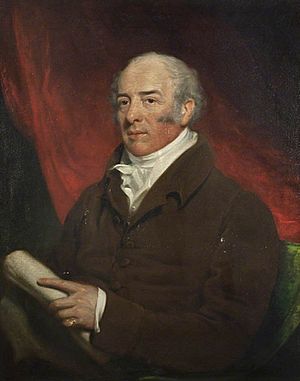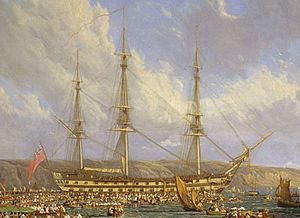William Johnstone Hope facts for kids
Quick facts for kids
Sir William Johnstone Hope
|
|
|---|---|

Hope in 1824, by James Ramsay
|
|
| Born | 16 August 1766 Finchley, Middlesex |
| Died | 2 May 1831 (aged 64) Bath, Somerset |
| Allegiance | |
| Service/ |
Royal Navy |
| Years of service | 1777 to 1830 |
| Rank | Royal Navy Vice-Admiral |
| Battles/wars | American Revolutionary War French Revolutionary Wars • Glorious First of June • Invasion of the Batavian Republic Napoleonic Wars |
| Awards | Commander of the Order of St John Knight Grand Cross of the Order of the Bath |
| Other work | Lord of the Admiralty MP for Dumfries Burghs, 1800–1802 MP for Dumfriesshire, 1804–1830 |
Sir William Johnstone Hope (born August 16, 1766 – died May 2, 1831) was an important officer in the Royal Navy and a politician in Britain. He had an exciting career that included big naval battles and even some disagreements with royalty. Hope was well-liked by his fellow officers. He served alongside famous figures like Horatio Nelson and Admiral Duncan.
After leaving the Royal Navy in 1804 due to poor health, Hope started a long career in Parliament. He spent 26 years as a Member of Parliament (MP). He also worked as a Lord of the Admiralty, helping to manage the navy, and as a commissioner for the Greenwich Naval Hospital. Hope passed away in 1831 after 55 years of serving his country in both the navy and politics. He was buried in his family's burial ground in Scotland.
Contents
William Johnstone Hope was the third son of John Hope and Mary Breton. His family was well-connected and had strong ties to politics. His brothers also became important people. Charles Hope became a judge, and Sir John Hope was a brigadier in the army, serving under Wellington.
William went to Edinburgh High School from 1774 to 1776. The very next year, when he was 12 years old, he joined the Royal Navy. He started as a midshipman on HMS Weazel. This ship was commanded by his uncle, Captain Charles Hope. William learned a lot from his uncle. He traveled with him on different ships during the American Revolutionary War. They served in areas like Britain, Lisbon, and Newfoundland.
In 1782, William was promoted to lieutenant. He then left his uncle's command and joined the frigate HMS Daedalus in Newfoundland. When the war ended, he sailed home on Daedalus. He stayed on this ship until 1785. His uncle then brought him back to his own ship, HMS Sampson, which was a guardship in Plymouth.
In 1786, Hope's career faced a challenge. He was assigned to HMS Pegasus, a frigate commanded by Prince William Henry. Hope and the Prince did not get along well. In less than a year, Hope was moved to another frigate, HMS Boreas. This ship was commanded by Captain Horatio Nelson, with whom Hope had a good relationship. Two years later, Hope moved to HMS Adamant. In 1790, when his commander, Sir Richard Hughes, became an admiral, Hope was promoted to commander and given command of Adamant.
Fighting in the French Revolutionary War
Hope continued to command smaller ships for several years. In 1792, he married his distant cousin, Lady Anne Hope Johnstone. They had two daughters and four sons together. Sadly, Anne passed away in 1818. In 1794, Hope commanded HMS Incendiary, a fireship that was part of the Channel Fleet. This fleet was sent to fight the French. In March of that year, Hope was promoted to post captain. He took command of HMS Bellerophon, a large warship that was the flagship for Admiral Thomas Pasley.
Hope was still in command of the Bellerophon three months later. He played a key role in the Glorious First of June battle. This was a major naval battle where the British fleet, led by Lord Howe, defeated a French fleet far out in the Atlantic Ocean. In early 1795, Hope joined HMS Tremendous. But within two months, Admiral Duncan asked him to join HMS Venerable. However, in 1796, Hope had a serious accident while visiting a Russian ship. He suffered a head injury that made him unable to work for two years. Because of this, he missed Admiral Duncan's important victory at the Battle of Camperdown.
After recovering, Hope was again requested by Admiral Duncan. He commanded Duncan's flagship, HMS Kent, for the next three years. In 1799, the Kent was Duncan's flagship during the Anglo-Russian invasion of the Batavian Republic (which is now the Netherlands). Hope was present when the Dutch fleet surrendered to the Royal Navy in Texel. He was sent back to Britain with the news of the surrender. Both the British and Russian leaders praised him. King George III gave him £500, and Tsar Paul I made him a Commander of the Order of St John.
In 1801, in the Mediterranean Sea, the Kent carried Sir Ralph Abercromby and his staff for the invasion of Egypt. This campaign was successful and forced the French army to surrender. Hope did not stay for the very end of this action. He returned to Britain with Admiral Duncan. For his service, he received the Order of the Crescent from Emperor Selim III. In 1800, Hope started his second career in politics. He became a Member of Parliament for Dumfries Burghs. He rarely visited his area or attended Parliament. He lost this seat in 1802 but was elected for Dumfriesshire in 1804. He held this position until he retired from public life in 1830.
In 1804, Hope briefly commanded HMS Atlas. However, it became clear that his health was not good enough for an active naval career. He retired from the navy. From 1804 to 1807, he was unwell. But when his health improved, he took a job as a Lord of the Admiralty. In this role, he helped manage the navy. He held this position for twenty years.
In 1812, Hope was promoted to rear-admiral. In 1815, he was made a Knight Commander of the Order of the Bath (KCB). From 1813 to 1818, Hope served as commander-in-chief at Leith. In 1819, he was promoted again, this time to vice-admiral. In 1820, he was called back to the Admiralty as the First Naval Lord. He stayed in this role for seven years. He remarried in 1821 to Maria Eden. In 1825, he was given an even higher honor, becoming a Knight Grand Cross of the Order of the Bath (GCB).
In 1827, Hope retired from his role at the Admiralty. He was given a good position as treasurer and later commissioner of the Royal Naval Hospital in Greenwich. Even though he had disagreements with Prince William many years earlier, when King William IV became king in 1830, he made Hope a privy councillor. Hope then fully retired later that year. He passed away in May 1831, a few months after leaving Parliament. Although he died in Bath, his body was returned to his family's burial place in Johnstone Church, Johnstone, Dumfriesshire.
Images for kids




